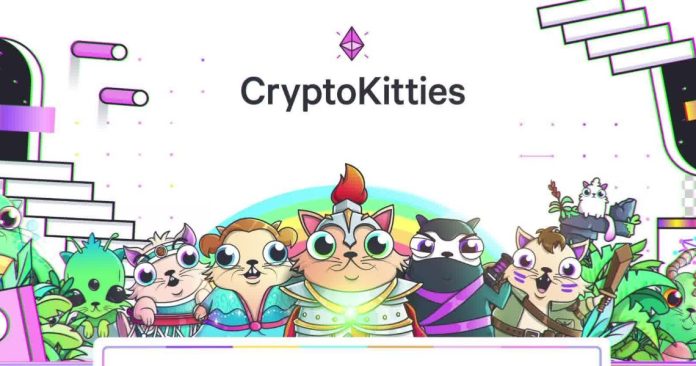CryptoKitties is the NFT collection that made history in 2017, but what happened to them now? How are their prices performing? Let’s take a closer look at them below.
CryptoKitties: what are the famous NFTs?
As one of the first and most popular NFT projects, CryptoKitties introduced blockchain technology to thousands of early users, players, traders, and collectors. In fact, the early days of the collection’s release and sales are now something of a crypto legend.
Interest in CryptoKitties has been so great since its inception that it has created an estimated six-fold increase in the number of Ethereum transactions. At one point, it accounted for 25% of the volume of transactions on the network.
The increase in volume caused a significant drop in transaction speed and an increase in gas rates across the entire Ethereum network. When this event occurred, at the peak of the 2017 bull-run cycle, it emphasized the scalability challenges of the Ethereum network and threatened to exclude other decentralized blockchain-based application startups.
Not only that, the demand for CryptoKitties NFTs can be partly credited to the 256-bit DNA sequence assigned to each. The unique characteristics of each CryptoKitty are derived from a combination of the cattributes of its parents.
This genome mechanism allows nearly four billion unique CryptoKitties to be minted from the parent CryptoKitties. The popularity of the CryptoKitties NFTs has also attracted high-profile celebrity collaborations.
Muse, a popular rock band, and Momo Wang, a famous Chinese fashion designer, have both participated in custom-themed cats for the CryptoKitties franchise. NBA superstar Stephen Curry was perhaps the most prominent celebrity to support the project. His initial involvement led to the creation of three CryptoKitty NFTs inspired by him.
Growth and decline of CryptoKitties
CryptoKitties, which launched on 28 November 2017 after a five-day closed beta, quickly gained notoriety with the tantalizing slogan “the world’s first Ethereum game.”
According to nonfungible.com, sales volume increased significantly from only 1,500 non-fungible cats on launch day to over 52,000 on 10 December 2017, with many CryptoKitties selling for prices in the hundreds or thousands of dollars.
In addition, the game’s use of the Ethereum blockchain may have contributed to the success of that technology. Along with the launch of CryptoKitties, Ethereum took off like a rocket, going from less than $300 per token in early November 2017 to just over $1,360 in January 2018.
However, CryptoKitties faltered when Ethereum rose higher, which would later prove to be a troubling indication for the future of blockchain games.
Early December 2017 saw a spike in daily sales, which declined in January and averaged less than 3,000 in March. The fact that the value of NFTs themselves declined more slowly is evidence that the game still has a strong fan following, including Rabono, who bought Dragon long after the game’s height.
Until 2018, their activity broke records for the value of NFTs. Nowadays, CryptoKitties are fortunate to reach 100 sales per day and the total value is often less than $10,000.
There are still significant transactions, such as the sale of Founder Cat No. 71 for 60 ether (about $170,000) on 30 April 2022, although they occur only occasionally. It is doubtful that CryptoKitties’ decline into obscurity will stop.
The company that owns CryptoKitties, Dapper Labs, has moved on to other businesses such as NBA Top Shot, a website that allows basketball fans to buy NFT “moments,” which are essentially video clips of NBA games.
Why have the popular NFTs collapsed?
The latest blog post (4 June 2021) on the game’s website, commemorating the breeding of the 2 millionth CryptoKitty, contains a hint about the end of the game. To date, it is believed that there are two main reasons why CryptoKitties have collapsed.
The first, concerns the amount of available kittens. In the sense that the more players increased demand, the more they also increased the ability to increase supply by breeding more cats. This has rapidly reduced the rarity of each NFT.
Second, there is the huge volume of CryptoKitties, which has effectively destroyed the Ethereum blockchain, the world’s second most valuable cryptocurrency by market capitalization (after Bitcoin).
As mentioned earlier, Ethereum values transactions using a fee called gas. Gas fees will increase whenever there is an increase in transactions (purchase, generation, and so on), and that is exactly what happened when CryptoKitties went to the moon.
Hence, high fees were a problem for more than just CryptoKitties. The entire blockchain was affected by the problem. As the game gained popularity, gas prices increased for anyone who needed to make a transaction on Ethereum for any reason.









